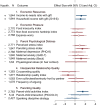Effects of unconditional cash transfers on family processes and wellbeing among mothers with low incomes
- PMID: 40804074
- PMCID: PMC12350725
- DOI: 10.1038/s41467-025-62438-x
Effects of unconditional cash transfers on family processes and wellbeing among mothers with low incomes
Abstract
This study examines causal impacts of unconditional cash transfers on economic hardship and key family processes that may affect children's development. The study randomized 1000 mothers of newborns, with prior-year household income below the federal poverty threshold, to receive unconditional cash transfers of $333 or $20 per month (Clinical Trial Registry number NCT03593356). Data collected approximately 12, 24 and 36 months after the child's birth show a moderate increase in household income and reductions in poverty; no statistically significant improvements in subjective economic hardship reports or quality of play with infants; and small, mostly statistically non-significant, increases in parental psychological distress and declines in mothers' relationship quality. However, mothers receiving the higher amount reported more frequently engaging in enriching child activities than mothers receiving the lower amount. Cash support may provide other benefits for families and children, but moderate support levels do not appear to address self-reported economic hardship or standard survey measures of maternal well-being. However, these results do not rule out the possibility of very small effects.
© 2025. The Author(s).
Conflict of interest statement
Competing interests: The authors declare no competing interests.
Figures


Similar articles
-
Cash Transfers and Their Effect on Maternal and Young Children's Health: A Randomized Clinical Trial.JAMA Pediatr. 2025 Aug 1;179(8):867-875. doi: 10.1001/jamapediatrics.2025.1612. JAMA Pediatr. 2025. PMID: 40522644 Free PMC article. Clinical Trial.
-
Unconditional cash transfers for reducing poverty and vulnerabilities: effect on use of health services and health outcomes in low- and middle-income countries.Cochrane Database Syst Rev. 2022 Mar 29;3(3):CD011135. doi: 10.1002/14651858.CD011135.pub3. Cochrane Database Syst Rev. 2022. PMID: 35348196 Free PMC article.
-
Unconditional cash transfers for reducing poverty and vulnerabilities: effect on use of health services and health outcomes in low- and middle-income countries.Cochrane Database Syst Rev. 2017 Nov 15;11(11):CD011135. doi: 10.1002/14651858.CD011135.pub2. Cochrane Database Syst Rev. 2017. Update in: Cochrane Database Syst Rev. 2022 Mar 29;3:CD011135. doi: 10.1002/14651858.CD011135.pub3. PMID: 29139110 Free PMC article. Updated.
-
Contraception use and satisfaction among mothers with low income: Evidence from the Baby's First Years study.Contraception. 2024 Jan;129:110297. doi: 10.1016/j.contraception.2023.110297. Epub 2023 Oct 6. Contraception. 2024. PMID: 37806470 Free PMC article. Clinical Trial.
-
Unconditional cash transfers for assistance in humanitarian disasters: effect on use of health services and health outcomes in low- and middle-income countries.Cochrane Database Syst Rev. 2015 Sep 11;2015(9):CD011247. doi: 10.1002/14651858.CD011247.pub2. Cochrane Database Syst Rev. 2015. PMID: 26360970 Free PMC article.
References
-
- National Academies of Sciences, Engineering, and Medicine A Roadmap to Reducing Child Poverty (The National Academies Press, Washington, DC, 2019). - PubMed
-
- Duncan, G. J., Magnuson, K., Kalil, A. & Ziol-Guest, K. The importance of early childhood poverty. Soc. Indic. Res.108, 87–98 (2012).
-
- Masarik, A. S. & Conger, R. D. Stress and child development: a review of the family stress model. Curr. Opin. Psychol.13, 85–90 (2017). - PubMed
-
- Ridley, M., Rao, G., Schilbach, F. & Patel, V. Poverty, depression, and anxiety: causal evidence and mechanisms. Science370, eaay0214 (2020). - PubMed
-
- Conger, R. D., Ge, X., Elder, G. H. Jr., Lorenz, F. O. & Simons, R. L. Economic stress, coercive family process, and developmental problems of adolescents. Child Dev.65, 541–561 (1994). - PubMed
Publication types
MeSH terms
Grants and funding
LinkOut - more resources
Full Text Sources

